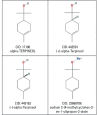An Informatics Approach to Evaluating Combined Chemical Exposures from Consumer Products: A Case Study of Asthma-Associated Chemicals and Potential Endocrine Disruptors
- PMID: 26955064
- PMCID: PMC4977060
- DOI: 10.1289/ehp.1510529
An Informatics Approach to Evaluating Combined Chemical Exposures from Consumer Products: A Case Study of Asthma-Associated Chemicals and Potential Endocrine Disruptors
Abstract
Background: Simultaneous or sequential exposure to multiple environmental stressors can affect chemical toxicity. Cumulative risk assessments consider multiple stressors but it is impractical to test every chemical combination to which people are exposed. New methods are needed to prioritize chemical combinations based on their prevalence and possible health impacts.
Objectives: We introduce an informatics approach that uses publicly available data to identify chemicals that co-occur in consumer products, which account for a significant proportion of overall chemical load.
Methods: Fifty-five asthma-associated and endocrine disrupting chemicals (target chemicals) were selected. A database of 38,975 distinct consumer products and 32,231 distinct ingredient names was created from online sources, and PubChem and the Unified Medical Language System were used to resolve synonymous ingredient names. Synonymous ingredient names are different names for the same chemical (e.g., vitamin E and tocopherol).
Results: Nearly one-third of the products (11,688 products, 30%) contained ≥ 1 target chemical and 5,229 products (13%) contained > 1. Of the 55 target chemicals, 31 (56%) appear in ≥ 1 product and 19 (35%) appear under more than one name. The most frequent three-way chemical combination (2-phenoxyethanol, methyl paraben, and ethyl paraben) appears in 1,059 products. Further work is needed to assess combined chemical exposures related to the use of multiple products.
Conclusions: The informatics approach increased the number of products considered in a traditional analysis by two orders of magnitude, but missing/incomplete product labels can limit the effectiveness of this approach. Such an approach must resolve synonymy to ensure that chemicals of interest are not missed. Commonly occurring chemical combinations can be used to prioritize cumulative toxicology risk assessments.
Citation: Gabb HA, Blake C. 2016. An informatics approach to evaluating combined chemical exposures from consumer products: a case study of asthma-associated chemicals and potential endocrine disruptors. Environ Health Perspect 124:1155-1165; http://dx.doi.org/10.1289/ehp.1510529.
Conflict of interest statement
The authors declare they have no actual or potential competing financial interests.
Figures



Comment in
-
An Informatics Approach to Reading the Label: Identifying Common Chemical Mixtures in Personal Care Products.Environ Health Perspect. 2016 Aug 1;124(8):A149. doi: 10.1289/ehp.124-A149. Environ Health Perspect. 2016. PMID: 27479446 Free PMC article. No abstract available.
-
Comment on "An Informatics Approach to Evaluating Combined Chemical Exposures from Consumer Products: A Case Study of Asthma-Associated Chemicals and Potential Endocrine Disruptors".Environ Health Perspect. 2016 Sep 1;124(9):A155. doi: 10.1289/EHP447. Environ Health Perspect. 2016. PMID: 27580876 Free PMC article. No abstract available.
-
Response to "Comment on 'An Informatics Approach to Evaluating Combined Chemical Exposures from Consumer Products: A Case Study of Asthma-Associated Chemicals and Potential Endocrine Disruptors'".Environ Health Perspect. 2016 Sep 1;124(9):A156. doi: 10.1289/EHP778. Environ Health Perspect. 2016. PMID: 27581111 Free PMC article. No abstract available.
References
-
- APUA (Alliance for the Prudent Use of Antibiotics) Boston, MA: Tufts University; 2011. Triclosan: White Paper Prepared by the Alliance for the Prudent Use of Antibiotics. Available: http://www.tufts.edu/med/apua/consumers/personal_home_21_4240495089.pdf [accessed 15 February 2016]
-
- Bolton EE, Wang Y, Thiessen PA, Bryant SH. PubChem: integrated platform of small molecules and biological activities. Annu Rep Comput Chem. 2008;4:217–240.
-
- Bornehag CG, Nanberg E. Phthalate exposure and asthma in children. Int J Androl. 2010;33(2):333–345. - PubMed
Publication types
MeSH terms
Substances
LinkOut - more resources
Full Text Sources
Other Literature Sources

